Swimming
Swimming holes are the ultimate summertime escape. Whether you're splashing around in a river, swimming in a lake, or taking a refreshing dip in a mountain stream, these natural pools offer a chance to cool off and have some fun in the sun. But where do you find the best swimming holes, and how do you know if they're safe to swim in? Here's everything you need to know about the magic of swimming holes.
A swimming holes a natural pool of water where people can swim, usually formed by the erosion of rocks or the damming of a river. These serene oases can be found all over the world, from tropical rainforests to arid deserts.
So where do you find these hidden gems? One of the best ways is to ask locals for recommendations. They might know of a secret spot that only the locals know about. You could also search here on Free Arenas to find swimming holes near you!
But how do you know if a swimming hole is safe to swim in? There are a few things to consider. First and foremost, beware of high water levels and nearby dams which contribute to the majority of river drownings. Dangerous high water is common with the spring runoff or at other times when temperature or irrigation changes mean more water in the rivers. Higher than usual water is faster and often carries other dangerous debris knocked loose from upriver. Be aware of what's downstream of you. Being sucked over a dam can lead to being held underwater and drowned, even if you're a very experienced swimmer. Check the water quality. If the water is murky or polluted, it's best to avoid swimming in it. You should also be aware of any potential hazards, such as rocks or submerged logs, and make sure to use caution when diving or jumping into the water.
So why swim in a natural pool when you could just go to a public pool or beach? For starters, swimming holes offer a more secluded and peaceful experience. There's nothing quite like the feeling of being surrounded by nature as you take a dip. Plus, many swimming holes are free to use, making them a budget-friendly option for a summer outing.
So next time the temperature starts to rise, grab your swimsuit and head out on a adventure to find the perfect swimming hole. Whether you're looking to cool off on a hot day or just want to experience the beauty of nature, there's no better way to beat the heat than by taking a plunge into a crystal-clear swimming hole.
Here's some of our favorite swimming holes
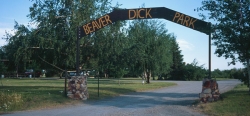
Beaver Dick Park
Rexburg, Idaho
5.7 miles W of Rexburg, IdahoBeaver Dick is a park 4.5 miles west of Rexburg, Idaho on Hwy 33. It's a 9.5 acre park that passes next to the west bank of the Henry Fork of the Snake River; it's a popular...
Camp, Canoe, Disc Golf, Swim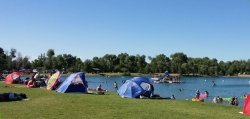
Jefferson County Lake (AKA Rigby Lake)
Rigby, Idaho
2.0 miles N of Rigby, IdahoRigby Lake has long been a favorite swimming hole for those in the area. The county has taken it well under its wing and made it a buzzing spot on any warm summer day. Along with the long standing...
Camp, Canoe, Dive, Kayak, Sled, Swim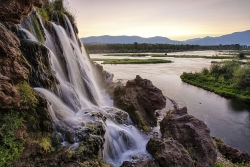
Fall Creek Falls
Swan Valley, Idaho
2.1 miles SW of Swan Valley, IdahoFalls Campground is located next to the Snake River near beautiful Swan Valley, only 45 miles east of Idaho Falls, Idaho. Mixed growth cottonwood trees provide partial shade, and grassy meadows with...
Camp, Cave, Hike, Kayak, Swim 11.6 mi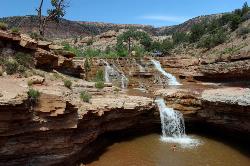
Toquerville Falls
La Verkin, Utah
6.6 miles N of La Verkin, UtahNothing says desert oasis quite like driving for 5.5 miles through winding sandy roads to find a favorite swimming hole with ledges, falls, and even a ladder to climb up to the best jumping spots....
Dive, Hike, Mountain Bike, Swim 0.2 mi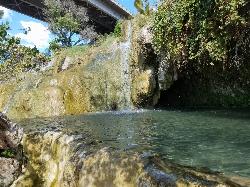
Little Jamaica aka Desert Springs
Littlefield, Arizona
0.8 miles NE of Littlefield, ArizonaLittle Jamaica is a warm springs waterfall and pool just off the highway between Desert Springs and Littlefield, Arizona. It's a family location that doesn't get more than 5 feet deep in the...
Hike, Swim 0.1 mi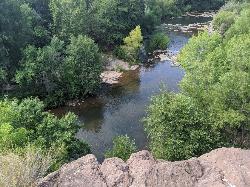
Mormons Crossing
Cornville, Arizona
2.4 miles NE of Cornville, ArizonaMormons Crossing is a little area along Oak Creek in Cornville, Arizona. Along this creek there are several holes deep enough to swim in, some rapids, and even a rope swing. It's a great spot to...
Swim 0.6 mi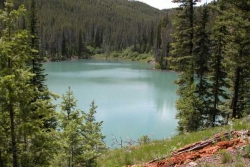
Packsaddle Lake
Tetonia, Idaho
9.3 miles W of Tetonia, IdahoPacksaddle is one of the less well known lakes/trails in the area. If you've got a good offroad vehicle, you can probably make it all the way to the end of the road, otherwise, it's just an...
Dive, Hike, Mountain Bike, Snowshoe, Swim 3.6 mi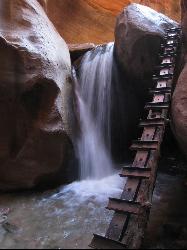
Kanarraville Falls
Kanarraville, Utah
0.5 miles E of Kanarraville, UtahKanarraville falls (also known as Kanarra falls) located outside of Cedar City, Utah is a must-see stop for any adventurous souls. Kanarra Falls is a medium length hike, both on trail and through...
Hike, Swim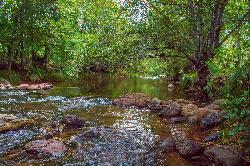
Chavez Crossing
Sedona, Arizona
2.1 miles SW of Sedona, ArizonaChavez Crossing is a campground in Sedona, Arizona. It sits perfectly nestled in Arizona's most beautiful red rock attractions along with the grand summer sunsets. If that didn't sound...
Camp, Hike, Swim 17.5 mi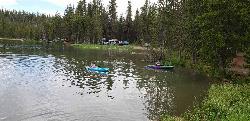
Tear Drop Lake
Ashton, Idaho
19.1 miles NE of Ashton, IdahoNestled in the Targhee National Forest just off of Ashton's Fish Creek Road, this tear drop shaped lake is a family adventure waiting to happen. The lake isn't very big but it is teeming with...
Camp, Canoe, Hike, Kayak, Mountain Bike, Swim- Plan Ahead and Prepare. Know the regulations and special concerns for the area you'll visit. Prepare for extreme weather, hazards, and emergencies. Schedule your trip to avoid times of high use. Visit in small groups when possible. Consider splitting larger groups into smaller groups. Repackage food to minimize waste. Use a map and compass to eliminate the use of marking paint, rock cairns or flagging.
- Travel & camp on durable surfaces. Durable surfaces include established trails and campsites, rock, gravel, dry grasses or snow. Protect riparian areas by camping at least 200 feet from lakes and streams. Good campsites are found, not made. Altering a site is not necessary.
- Dispose of waste properly. Pack it in, pack it out. Inspect your campsite and rest areas for trash or spilled foods. Pack out all trash, leftover food and litter. Deposit solid human waste in catholes dug 6 to 8 inches deep, at least 200 feet from water, camp and trails. Cover and disguise the cathole when finished. Pack out toilet paper and hygiene products. To wash yourself or your dishes, carry water 200 feet away from streams or lakes and use small amounts of biodegradable soap. Scatter strained dishwater.
- Leave what you find. Preserve the past: examine, but do not touch cultural or historic structures and artifacts. Leave rocks, plants and other natural objects as you find them. Avoid introducing or transporting non-native species. Do not build structures, furniture, or dig trenches.
- Minimize campfire impacts. Campfires can cause lasting impacts to the environment. Use a lightweight stove for cooking and enjoy a candle lantern for light. Where fires are permitted, use established fire rings, fire pans, or mound fires. Keep fires small. Only use sticks from the ground that can be broken by hand. Burn all wood and coals to ash, put out campfires completely, then scatter cool ashes.
- Respect wildlife. Observe wildlife from a distance. Do not follow or approach them. Never feed animals. Feeding wildlife damages their health, alters natural behaviors, and exposes them to predators and other dangers. Protect wildlife and your food by storing rations and trash securely. Control pets at all times, or leave them at home. Avoid wildlife during sensitive times: mating, nesting, raising young, or winter.
- Be considerate of other visitors. Respect other visitors and protect the quality of their experience. Be courteous. Yield to other users on the trail. Step to the downhill side of the trail when encountering pack stock. Take breaks and camp away from trails and other visitors. Let nature's sounds prevail. Avoid loud voices and noises.

















